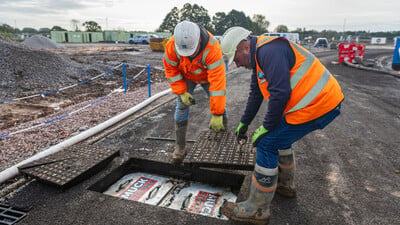Manhole covers are an essential feature of our urban and industrial infrastructure, protecting access points to underground utilities such as sewerage, drainage and telecommunications systems. However, lifting and moving these covers can present a range of challenges, from physical strain to logistical difficulties. This article explores the types of manhole covers, the risks of handling them manually, and the equipment available to make the job safer and more efficient.
Types of Manhole Covers and Their Handling Challenges
Manhole covers come in various materials, sizes and designs, each of which presents specific challenges during handling.
Cast iron covers are among the most commonly used due to their durability and strength. However, they are also incredibly heavy, often weighing more than 50 kilograms, making manual handling difficult and risky.
Composite manhole covers, on the other hand, are made from lightweight materials like reinforced plastic or resin. While they are easier to manage due to their reduced weight, careful lifting techniques should still be used to avoid injuries.
Steel and aluminium covers provide a middle ground, offering strength with moderate weight, but their large, flat shapes can still make them awkward to handle manually.
Concrete covers, frequently used in industrial or heavy-duty settings, are the heaviest of all and present significant challenges.
Moving these covers without specialised equipment is almost impossible. In addition to their weight, many covers fit tightly into frames to prevent water ingress or tampering, making them even harder to lift without mechanical assistance.
Health and Safety Risks of Moving Manhole Covers
Lifting manhole covers manually without proper techniques or tools can lead to both immediate and long-term health problems. One of the most common risks is back injuries caused by the heavy lifting required. Manhole covers often need to be moved from awkward positions, forcing workers to adopt postures that strain their lower back muscles. If this is done repeatedly, it can lead to chronic pain or even more serious issues like herniated discs.
There is also a significant risk of crush injuries. A slipping manhole cover can easily trap fingers or toes, causing serious damage. Strains and sprains are another concern, particularly when workers are forced to use excessive force to lift a stuck cover. This can affect the shoulders, wrists, or knees and the risk increases when the ground is wet or uneven, making stability more difficult.
Over time, poor manual handling practices can lead to repetitive strain injuries or chronic musculoskeletal disorders, which may reduce a worker’s mobility or ability to work altogether. Employers must take these risks seriously, as failure to provide safe working conditions can result in both health complications for employees and legal repercussions for the organisation.
Tools and Equipment for Safe Manhole Cover Lifting
To address the challenges of lifting manhole covers, a range of specialised tools and equipment is available to make the task safer and more efficient. One of the simplest options is the manhole key. These are basic tools designed to hook into the cover’s lifting points, allowing workers to lift manually. While effective for lighter covers, they do not reduce the physical effort required for heavier ones.
For steel and cast-iron covers, magnetic lifters offer a more sophisticated solution. These tools use strong magnets to secure the cover, allowing for easy lifting and repositioning. They are particularly useful when covers need to be moved by a single person, reducing the risk of strain injuries.
Hydraulic lifters are an excellent choice for particularly heavy or difficult-to-remove covers, such as those made from concrete or tightly fitted cast iron. These lifters use hydraulic power to lift the cover with minimal physical effort, making them ideal for industrial applications.
Another versatile option is the portable cover lifter, which combines levers and wheels to make the process of lifting and moving manhole covers both simple and safe. These lifters are especially useful in environments with uneven surfaces or limited space.
Proper use of these tools is essential to ensure safety. Workers should receive training in the correct handling of lifting equipment, and all tools must be inspected regularly to ensure they remain in good working condition. Matching the right tool to the specific type of manhole cover is also crucial. For example, using a magnetic lifter on a non-metallic composite cover would be ineffective, while a hydraulic lifter might be excessive for lightweight materials.

Written by
Vicki James
Sales & Marketing Coordinator
Vicki is a vital part of the marketing team; from reporting to copywriting, she ensures we complete projects on time.

